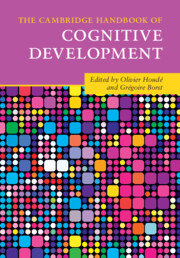Book contents
- The Cambridge Handbook of Cognitive Development
- The Cambridge Handbook of Cognitive Development
- Copyright page
- Contents
- Figures
- Tables
- Contributors
- Introduction
- Part I Neurobiological Constraints and Laws of Cognitive Development
- Part II Fundamentals of Cognitive Development from Infancy to Adolescence and Young Adulthood
- Introduction
- Subpart II.1 Infancy: The Roots of Human Thinking
- Subpart II.2 Childhood and Adolescence: The Development of Human Thinking
- 15 Development of Qualitative Thinking
- 16 Development of Numerical Knowledge
- 17 Numerical Cognition and Executive Functions
- 18 Developing Theory of Mind and Counterfactual Reasoning in Children
- 19 Development of Executive Function Skills in Childhood
- 20 Developing Cognitive Control and Flexible Adaptation during Childhood
- 21 Reasoning Bias and Dual Process Theory
- 22 Social Cognitive Development
- 23 Behavioral and Neural Development of Cognitive Control and Risky Decision-Making across Adolescence
- 24 The Triadic Neural Systems Model through a Machine-Learning Mill
- Part III Education and School-Learning Domains
- Index
- Plate Section (PDF Only)
- References
23 - Behavioral and Neural Development of Cognitive Control and Risky Decision-Making across Adolescence
from Subpart II.2 - Childhood and Adolescence: The Development of Human Thinking
Published online by Cambridge University Press: 24 February 2022
- The Cambridge Handbook of Cognitive Development
- The Cambridge Handbook of Cognitive Development
- Copyright page
- Contents
- Figures
- Tables
- Contributors
- Introduction
- Part I Neurobiological Constraints and Laws of Cognitive Development
- Part II Fundamentals of Cognitive Development from Infancy to Adolescence and Young Adulthood
- Introduction
- Subpart II.1 Infancy: The Roots of Human Thinking
- Subpart II.2 Childhood and Adolescence: The Development of Human Thinking
- 15 Development of Qualitative Thinking
- 16 Development of Numerical Knowledge
- 17 Numerical Cognition and Executive Functions
- 18 Developing Theory of Mind and Counterfactual Reasoning in Children
- 19 Development of Executive Function Skills in Childhood
- 20 Developing Cognitive Control and Flexible Adaptation during Childhood
- 21 Reasoning Bias and Dual Process Theory
- 22 Social Cognitive Development
- 23 Behavioral and Neural Development of Cognitive Control and Risky Decision-Making across Adolescence
- 24 The Triadic Neural Systems Model through a Machine-Learning Mill
- Part III Education and School-Learning Domains
- Index
- Plate Section (PDF Only)
- References
Summary
Adolescence, which is defined as the transition phase between childhood and adulthood, roughly between ten and twenty-two years of age, is marked by pronounced behavioral changes in cognitive control and decision-making (Crone & Dahl, 2012). For instance, adolescents show with advancing age an increased ability to control impulses and increases in goal-directed behavior (Hofmann et al., 2012). At the same time, adolescence is often characterized by an increase in exploratory and risk-taking behavior, possibly related to the need to develop independence from parents and develop their identity (Steinberg, 2008). In addition to these behavioral changes, adolescence is marked by profound neural changes both in functional brain activity and connectivity, and in terms of structural brain changes and connections (Mills & Tamnes, 2014). In this chapter, we will discuss current literature on two aspects that develop in tandem across adolescence, cognitive control (Section 23.1) and risky decision-making (Section 23.2; for an overview of paradigms to measure these two aspects, see Table 23.1), as well as their neural developmental patterns (for an overview of brain regions and connections, see Figure 23.1). Section 23.1 covers the development of cognitive control and how structural brain development and sex steroids contribute to this development. Section 23.2 discusses which underlying behavioral and functional neural factors contribute to the development of risky decision-making. Finally, Section 23.3 converges the two parts and considers avenues for future research.
- Type
- Chapter
- Information
- The Cambridge Handbook of Cognitive Development , pp. 500 - 515Publisher: Cambridge University PressPrint publication year: 2022



